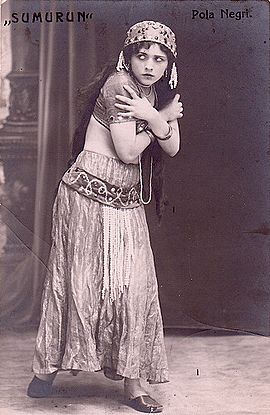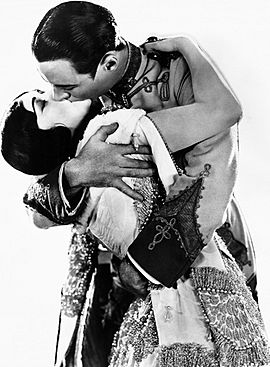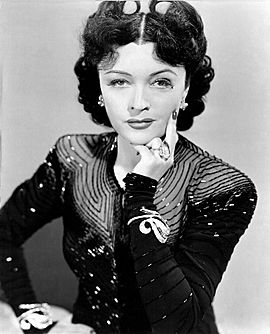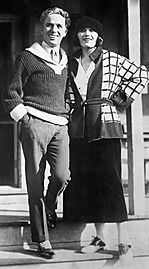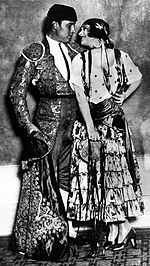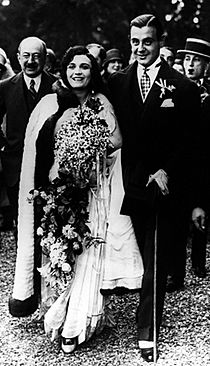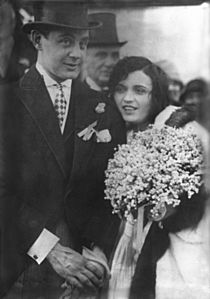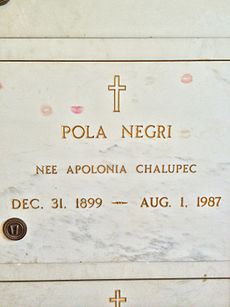Pola Negri facts for kids
Quick facts for kids
Pola Negri
|
|
|---|---|
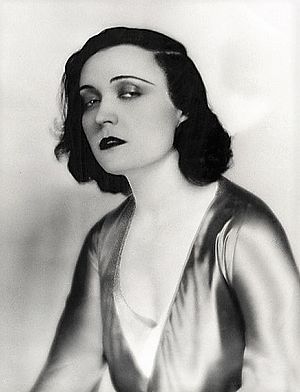
Negri in 1931
|
|
| Born |
Barbara Apolonia Chalupec
3 January 1897 Lipno, Kingdom of Poland, Russian Empire
|
| Died | 1 August 1987 (aged 90) San Antonio, Texas, U.S.
|
| Resting place | Calvary Cemetery (Los Angeles), California, U.S. |
| Nationality | Polish |
| Occupation |
|
| Years active | 1914–1964 |
| Spouse(s) |
Count Eugeniusz Dąbski
(m. 1919; div. 1922)Prince Serge Mdivani
(m. 1927; div. 1931) |
Pola Negri (born Barbara Apolonia Chalupec; January 3, 1897 – August 1, 1987) was a famous Polish actress and singer. She became a huge star around the world during the silent movie era and the Golden Age of Hollywood. She was known for playing strong, dramatic characters and mysterious, charming women.
Pola grew up in Poland and faced many challenges. Her father was sent away, and her mother raised her in poverty. Pola also got sick with tuberculosis as a teenager. After she got better, she studied ballet and acting in Warsaw. She became a well-known stage actress there. In 1917, she moved to Germany and started acting in silent films for the UFA studio. Her amazing performances caught the eye of Hollywood movie bosses at Paramount Pictures.
Paramount signed Pola Negri in 1922. This made her the first European actress ever to get a contract in Hollywood! She spent most of the 1920s in the United States. She appeared in many films for Paramount and became one of the most popular actresses in American silent movies. In the 1930s, when movies started having sound, Pola went back to Europe. She made several films for Pathé Films and UFA. She also began a career as a singer. After 1940, she only made two more films. Her last movie was Walt Disney's The Moon-Spinners in 1964.
Pola Negri lived a quiet life away from the public eye later on. She became a U.S. citizen in 1951. She spent the rest of her life in San Antonio, Texas. She passed away in 1987 at the age of 90.
Contents
Early Life and Beginnings
Pola Negri was born Barbara Apolonia Chalupec on January 3, 1897. This was in Lipno, which was part of Poland under Russian rule at the time. She was the only one of three children to survive. Her mother, Eleonora Kiełczewska, came from a poor noble family. Pola's father, Juraj Chalupec, was a traveling tinsmith. He was arrested for revolutionary activities and sent to Siberia. After this, Pola and her mother moved to Warsaw. They lived in poverty, and her mother worked as a cook to support them.
Pola was raised Catholic by her mother. When she was young, she was accepted into Warsaw's Imperial Ballet Academy. She performed in famous ballets like Swan Lake and Coppélia. However, she got tuberculosis and had to stop dancing. She went to a special hospital in Zakopane to get better. During her recovery, she chose the stage name Pola Negri. "Pola" was short for her real name, Apolonia. "Negri" came from an Italian writer and poet named Ada Negri.
Becoming a Star
Polish Stage and Film
After getting well, Pola successfully tried out for the Warsaw Imperial Academy of Dramatic Arts. She also took private acting lessons. She made her first appearance on stage in Warsaw in 1912.
In 1913, she made her stage debut in Hannele. The next year, she appeared in her first film, Niewolnica zmysłów. She kept performing on stage while finishing her studies. By the end of World War I, Pola was a very popular stage actress. She also starred in many films made in Warsaw. These included Bestia (known as The Polish Dancer in the U.S.) and Room No. 13.
German Silent Films and Hollywood Call
Pola's fame in Poland led her to Berlin, Germany, in 1917. There, she performed in a play called Sumurun. She met Ernst Lubitsch, who was making comedies for the German film studio UFA. Pola first made six films with Saturn Films. Then, she signed with UFA. Some of her UFA films included Mania (1918) and Der Gelbe Schein (The Yellow Ticket).
In 1918, Lubitsch convinced UFA to make a big film with Pola as the main character. This was Die Augen der Mumie Ma (The Eyes of the Mummy Ma). It was a huge hit! This led to many more successful films with Lubitsch and Negri. These included Carmen (1918) and Madame DuBarry (1919). Madame DuBarry became a massive international success. It even helped German films become popular in America. Pola and Lubitsch made three more German films together.
Hollywood noticed Pola's talent. Jesse Lasky, a big boss at Paramount Pictures, saw Madame DuBarry in Berlin. Paramount invited Pola to Hollywood in 1921. She signed a contract for $3,000 a week! She arrived in New York on September 12, 1922, with lots of media attention. This made Pola Negri the first European star to be brought to Hollywood. She paved the way for other European actresses like Greta Garbo.
Hollywood Success
Pola Negri became one of the most popular actresses in Hollywood. She was also one of the richest women in the film industry at that time. She lived in a mansion in Los Angeles that looked like the White House. While in Hollywood, she started many fashion trends. These included red painted toenails, fur boots, and turbans.
Her first two Paramount films were Bella Donna (1923) and The Cheat (1923). Her first big movie was The Spanish Dancer (1923). This film was originally planned for Rudolph Valentino.
Paramount often cast Pola as a mysterious European woman who wore fancy clothes. They even created a fake rivalry between her and actress Gloria Swanson. Pola felt Paramount was not managing her career well. So, she asked Ernst Lubitsch to direct her in Forbidden Paradise (1924). This was their last film together. By 1925, some American audiences were getting tired of her very fancy image.
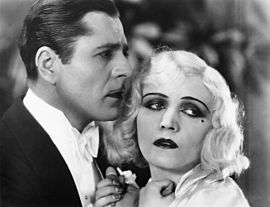
In 1927, Paramount started casting Pola in more down-to-earth roles. This was to make her seem more relatable. She starred in films like Hotel Imperial. However, her next films did not do as well. This was partly because of negative news about her behavior at Rudolph Valentino's funeral. She was seen crying a lot and fainting. She also quickly married Prince Serge Mdivani. Pola defended herself, saying her emotions seemed "exaggerated to Americans" because she was a Slav.
In 1928, Pola was earning $10,000 a week. She made three more films before her last one for Paramount, The Woman from Moscow. Pola later said she chose not to renew her contract. She wanted to retire from movies and live as a wife. By 1929, she had reportedly earned $5 million.
Later Career and Retirement
Pola's retirement in 1928 did not last long. She sadly lost her baby. She also found out her husband was losing her money. This caused problems in their marriage. She went back to acting in a British film called The Way of Lost Souls (1929). This was her last silent film.
Pola returned to Hollywood in 1931 for her first talking film, A Woman Commands (1932). The movie itself was not very popular. However, Pola's song "Paradise" from the film became a big hit. She went on a successful tour to promote the song.
After this, Pola went to France to appear in Fanatisme (1934). This was her only French film. Then, she was invited to Germany to star in the film Mazurka (1935). This film was very well-regarded. After Mazurka's success, Pola signed a new contract with her old studio, UFA. She made five more films with them, including Moscow–Shanghai (1936) and Tango Notturno (1937).
When the Nazis took over France, Pola fled back to the United States in 1940. She was hired for a supporting role in the 1943 comedy Hi Diddle Diddle. After this film, she was offered similar roles, but she turned them down. In 1945, she retired from the entertainment business.
Final Appearances
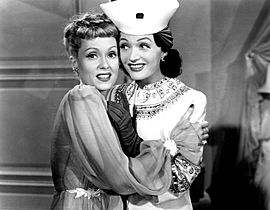
In 1948, director Billy Wilder asked Pola to play Norma Desmond in the film Sunset Boulevard (1950). Pola reportedly turned down the role.
Pola came out of retirement to appear in the Walt Disney film The Moon-Spinners (1964). She played an interesting jewel collector named Madame Habib. While filming in London, she surprised the press by appearing with a cheetah on a leash! In 1970, she published her autobiography, Memoirs of a Star. She also attended special screenings of her films.
In 1975, director Vincente Minnelli asked Pola to be in A Matter of Time. However, Pola did not accept due to poor health. Her final public appearance for a "Where Are They Now?" article was in Life magazine in 1980.
Personal Life
Pola Negri's first marriage was to Count Eugeniusz Dąbski. They married in Poland in 1919, but their marriage was short. They divorced in 1922.
After moving to the United States, Pola was often in the news for her relationships with famous actors. These included Charlie Chaplin and Rudolph Valentino. She had met Chaplin in Germany. Their friendship grew into a well-known relationship. Pola was also involved with actor Rod La Rocque for a time.
Pola met Rudolph Valentino at a party. She was reportedly his girlfriend until he passed away in 1926. She caused a big stir at his funeral in New York. She was very emotional and had a large flower arrangement spelling "P-O-L-A" placed on his coffin. At the time of his death, and for the rest of her life, Pola said Valentino was the love of her life.
Pola married again soon after Valentino's death. She married Serge Mdivani, who called himself a "Prince." They married on May 14, 1927. Pola became pregnant and wanted to be a housewife and mother. However, she sadly suffered a miscarriage. She grieved the loss of her child for the rest of her life. She and Mdivani divorced in 1931.
In 1932, Pola performed with singer Russ Columbo. They were briefly involved. Columbo even recorded Pola's song "Paradise" and dedicated it to her.
When Pola returned to the United States in the early 1940s, she became close friends with Margaret West. Margaret was an oil heiress and actress. The two became housemates, living together in Los Angeles. Pola, who remained a strong Catholic, spent her time raising money for Catholic charities. On January 12, 1951, Pola became a U.S. citizen. After her mother passed away in 1954, Pola and Margaret moved to San Antonio, Texas, in 1957. Pola lived with Margaret until Margaret's death in 1963. Pola then moved to a townhouse in San Antonio. She lived there quietly for the rest of her years.
Death and Legacy
Pola Negri passed away on August 1, 1987, at age 90. She died from pneumonia. She had also been dealing with a brain tumor. Her death was widely reported in newspapers.
Pola Negri was buried next to her mother in Calvary Cemetery in East Los Angeles. Since she had no children or siblings, she left most of her belongings to St. Mary's University in Texas. This included a collection of her movie items and rare film copies. St. Mary's University also created a scholarship in her name. She also gave a large part of her estate to Polish nuns.
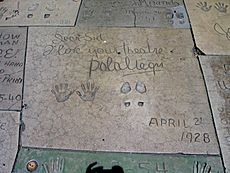
Pola Negri has a star on the Hollywood Walk of Fame for her work in movies. She was one of the first stars to place her hand and foot prints in front of Grauman's Chinese Theatre. She also has a star in Poland's Walk of Fame in Łódź. Poland's post office even issued a stamp honoring her in 1996. The Polish Film Festival of Los Angeles gives out the Pola Negri Award to talented film artists. There is also a Pola Negri Museum in Lipno, which gives a "Polita" award.
Pola Negri's eyes, along with those of Theda Bara and Mae Murray, were combined to create the logo for the Chicago International Film Festival.
Pola Negri also makes a small appearance in the TV film Young Indiana Jones and the Hollywood Follies. In the film, Indiana Jones sees her dancing with Valentino at a party.
In 2006, a documentary about Pola's life, Pola Negri: Life Is a Dream in Cinema, was shown. It was directed by her biographer, Mariusz Kotowski. The film included interviews with Hayley Mills and Eli Wallach, who were in Pola's last film. This documentary has been shown at film events in Europe and the U.S.
Kotowski also wrote two books about Pola Negri. One is in Polish, and the other is in English, called Pola Negri: Hollywood's First Femme Fatale. He also put together a DVD collection of her early films.
Images for kids
-
Drawing of Pola Negri by Milena Pavlović-Barili
-
Negri with Warner Baxter in a publicity still for Three Sinners (1928)
-
Martha Scott and Negri in a publicity still from Hi Diddle Diddle (1943)
-
Signature and prints of Negri's hands and feet in front of Grauman's Chinese Theatre
See also
 In Spanish: Pola Negri para niños
In Spanish: Pola Negri para niños
- List of Poles


